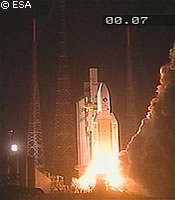Lift-off for Rosetta comet mission
The European Space Agency (ESA) Rosetta spacecraft was successfully launched from Kourou, French Guiana, at 8:17 Central European Time on 2 March. Rosetta will be the first craft to both chase and land on a comet. The launch of the one billion euro probe was originally planned for 26 February, but a combination of high winds and technical problems delayed the launch by five days. Although infuriating for those closely involved in the project, those following the progress of the mission know that they need to have a huge amount of patience. Rosetta is not expected to enter the orbit of Comet 67P/Churyumov-Gerasimenko until 2014. 'The launch of Rosetta from the European Space Port in French Guiana shows what Europe is capable of in space: the ability to send an interplanetary probe into space to land on a comet in 2014,' said EU Research Commissioner Philippe Busquin, welcoming the launch. 'This has never been undertaken before. Science and exploratory missions are of great importance to maintaining Europe's leading role in space. Alongside the upcoming integration of the Russian 'Soyuz' rockets in Kourou, we take another step towards becoming a globally responsible space power.' Rosetta comprises a large orbiter and a small lander. Between them, the two components are carrying 20 scientific instruments designed to complete the most detailed study of a comet ever attempted. The instruments include: an ultraviolet imaging spectrometer; a grain impact analyser and dust accumulator; a micro-imaging analysis system; an alpha proton x-ray spectrometer; an evolved gas analyser and a RoLand magnetometer and plasma monitor. The spacecraft and upper stage remained in the Earth's orbit for around two hours after lift-off. The upper stage then ignited to boost Rosetta into its interplanetary trajectory and separated from the spacecraft. The spacecraft will now set off on its long Solar System journey that will take it around the Sun four times, around Mars once (2007), the Earth three times (2005, 2007, 2009), and into the asteroid belt twice. The target of the mission, Comet 67P/Churyumov-Gersimenko, has a nucleus about four kilometres wide and orbits around the Sun every 6.6 years. Rosetta will orbit the Comet, observing what happens as the icy nucleus approaches the Sun and then moves away from it. Rosetta's industrial team involves more than 50 contractors from 14 European countries and the US.



